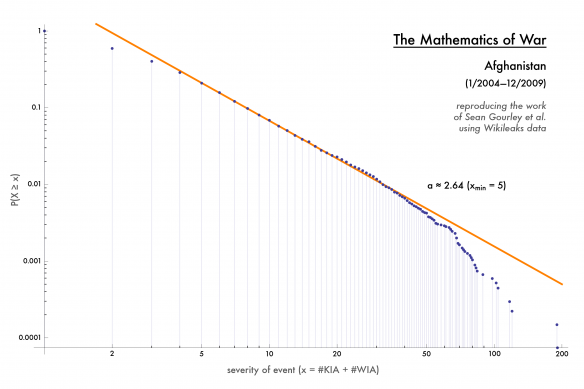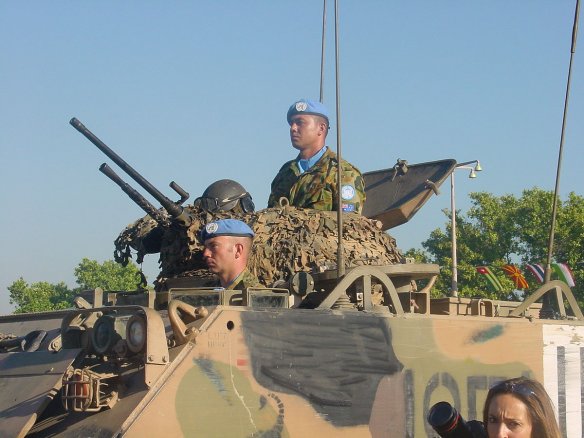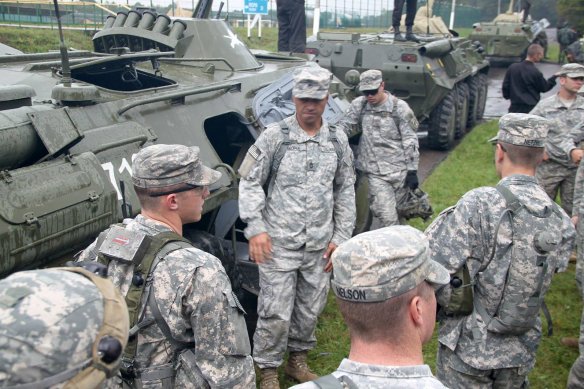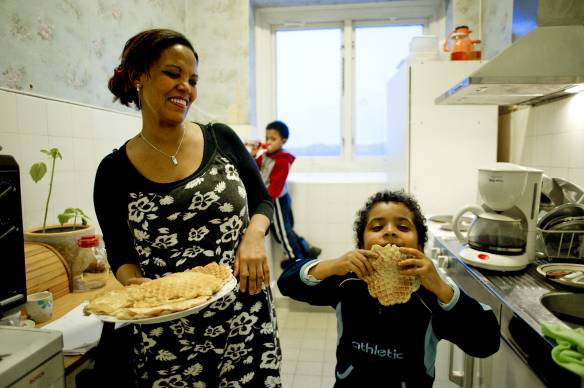Monday 2 February At least five people were killed and seven others wounded when unknown gunmen attacked a village in Jalle payam in Jonglei’s Bor county. Abdalla Kuot, spokesperson for rebel fighters under the overall command of General Dau Aturjong, said the SPLA (IO) planned to intensify its recruitment efforts in and outside South Sudan… Read more »
Data Challenges in Conflict Research
Quality data is at the heart of quality research. The scholarly community depends on valid, reliable, and easily accessible data in order to empirically test our theories of social and political processes. Yet quantitative data is not “truth” in an absolute sense, but rather, is a numeric representation of complex phenomena. For conflict researchers, the challenge of collecting quality data is particularly acute given the nature of our enterprise.

A graph of the frequency and severity of violent incidents in Afghanistan. By Max Braun.
Given the costs and risks involved, it is practically impossible to observe every battle, civilian massacre, human rights violation, or protest event. Therefore, we often rely upon other sources — journalists, non-governmental organizations, truth commissions, and so on — to report on key features of a conflict, then turn such information into numeric values. Turning such reports into data isn’t a trivial task, but requires digesting large amounts of text, sorting through often-conflicting information, making judgments about coding rules, and dealing with ambiguous cases.
Recently, there have been a number of conversations in the conflict studies community about the challenge of collecting data that is accurate, replicable, and inter-operable with existing data. One such discussion occurred during a workshop held at the 2013 Annual Meeting of the International Studies Association in San Francisco, where several key figures from leading data collection projects were gathered. Some of the key concepts and ideas from that workshop were recently turned into a series of short articles, just published as a special feature of the Journal of Peace Research. In that special feature, scholars discuss their own experiences (good and bad) with collecting data, updates on current data projects, and practical tools for future data collection, all with an eye on common standards and best practices (for an exemplary discussion of best practices, see this paper by Christian Davenport and Will Moore).
Read more in the post at Political Violence @ A Glance.
Peacekeeping Works
An assessment of the effectiveness of UN peacekeeping operations
The increase in the deployment of UN ‘blue helmets’ is a key driver of the gradual decline in the number and severity of armed conflicts worldwide since the mid-1990s. This brief summarizes a study that assesses the complete, long-term effectiveness of UN peacekeeping operations. It shows a remarkably strong combined effect of UN operations’ ability to contain the lethality of wars as well as preventing them from reerupting or spreading.

UN Peacekeepers in East Timor. Photo: Geoffrey C. Gunn. Licensed under CC BY 3.0 via Wikimedia Commons
The Effect of Proposed US Arms Supplies to Ukraine
A report published on Monday by the Atlantic Council, the Brookings Institution, and the Chicago Council on Global Affairs that calls for the US to supply Ukraine with arms has generated a lot of discussion on both sides of the Atlantic.

Image from the Rapid Trident 2014 training exercise which took place in Ukraine during September 2014 and involved troops from Ukraine, NATO members and other states.
Written by eight high ranking former US diplomats, defence and military personnel – Ivo Daalder, Michele Flournoy, John Herbst, Jan Lodal, Steven Pifer, James Stavridis, Strobe Talbott and Charles Wald – the report called for the supply by the USA of military equipment to Ukraine. Most of the equipment suggested is ‘non-lethal’, namely: radar that would identify the location of artillery being fired; secure communications equipment; unmanned aerial vehicles (UAVs or drones) designed for reconnaissance; electronic jamming equipment to counter enemy UAVs; armoured Humvee vehicles; and medical equipment.
Always an Immigrant, Never Norwegian
Immigrants have become integrated into Norwegian society with degrees of success that range between two possible extremes: strong attachment and total alienation. In debates about integration, ethnicity and country of origin are often claimed to be the key factors for determining whether or not integration will be successful. Other important factors are seen as secondary. This contributes to the one-track nature of debates about integration.

Foto: Werner Anderson/Norwegian Peoples Aid. V`CC BY 2.0
The significance of time
Politicians, the media and researchers tend to focus on where a person “is from”. But in our research on migration – including in particular the relative strength of an immigrant’s sense of attachment to Norway versus his or her sense of attachment to people and places in other countries – we find that two other questions are just as relevant: “When did you come to Norway?”; and “How old were you when you arrived?” For one of our research projects we interviewed 67 people originating from 21 different countries, including Australia, Brazil, Iran, Pakistan, Poland and Sri Lanka. The interviewees had either come to Norway recently; during their childhood; or been born in Norway to two immigrant parents. Despite their very diverse national backgrounds, the interviewees had much in common when asked about their senses of belonging.Read More
Russia Makes Haste in Severing Ties with Europe

On the road in Eastern Ukraine (photo from Novaya gazeta).
Russia has achieved much success last week in its rush toward self-isolation, and perhaps the most demonstrative step was made in the Parliamentary Assembly of the Council of Europe (PACE). Sergei Naryshkin, the Chairman of the State Duma, came to Strasbourg as the head of the Russian delegation expecting to reach a compromise on the issue of restoring Russia’s full participation in this important pan-European forum. But he was so irked by the international body’s decision to prolong its sanctions against Russia (including the suspension of the right to vote) for another three months that he stormed out of the Palace of Europe and announced that his country would abstain from partaking in the PACE proceedings until the end of 2015.
The rest of the article is in Eurasia Daily Monitor, February 2.
This Week in South Sudan – Week 5
Monday 26 January Foreign Policy article ‘Inside the White House Fight over the slaughter in South Sudan’ focuses on the threat of an arms embargo and the slow pace of American diplomacy on South Sudan. South Sudan fighting grinds on, one year after the Cessation of Hostilities agreement was signed. Tuesday 27 January The UN… Read more »
Why Assisted Return Programmes Must Be Evaluated
Rejected asylum seekers often resist the legal obligation to return. Consequently, European policy makers tasked with migration managament have turned to so-called ‘Assisted Voluntary Return and Reintegration programmes’ (AVRRs) to incentivize return to and support reintegration in the country of origin. Such programmes are described as less politically costly, more humane, simpler and cheaper than deportation. But with very limited monitoring and evaluation of AVRRs we know little about how well they work and whether the promised support is given. In a recent policy brief, I outline some of the compelling reasons to monitor and evaluate AVRRs.

It may seem as if return programmes are all about logistics, but a comprehensive evaluation should raise a wide range of analytical questions. Image: radarqnet, and Lauren Manning, used under CC BY 2.0.
Legality and Courtesy
In his opinion article in the Norwegian newspaper Aftenposten on 21 January, Per Edgar Kokkvold (secretary general in the Norwegian Press Association) stated the obvious, “It is people who must be protected – and who are protected under current legislation, under the law that prohibits discriminatory or hateful utterances, persecution or insults based on religion or belief. But here it is the individual person who is protected, not the religion. Religions and beliefs must be open to insult.”
This is the position under Norwegian law, and this is the position that Norwegian politicians – and the Church of Norway – want to continue.
What is more remarkable is that Kokkvold does not comprehend that this was the position adopted by the Ministry of Foreign Affairs in 2006 in the very statement that Kokkvold cites: the Ministry of Foreign Affairs has “great understanding” for the fact that the Danish caricatures “are experienced as offensive by Muslims worldwide”.
Expressing “great understanding” is not the same as saying that the caricatures should be illegal. It is a phrase that conveys empathy.
Amid Mounting Domestic Troubles, Putin Tries to Regain Initiative in Eastern Ukraine

Russia makes a bit of Winter War in Ukraine.
The sharp escalation of hostilities in eastern Ukraine last week (January 22) has disheartened many in Europe who had hoped for a gradual resolution of the Ukraine conflict. On the other hand, it has been a welcome return to the path of victory for many in Russia who consume or produce the flow of war propaganda. For some observers, the fragility of the ceasefire and the impossibility of “freezing” the conflict in the present configuration were beyond doubt, so the question that is looming large in the commentary is not “Why?” but rather “Why now?”
The rest of the article can be read in Eurasia Daily Monitor, January 26.